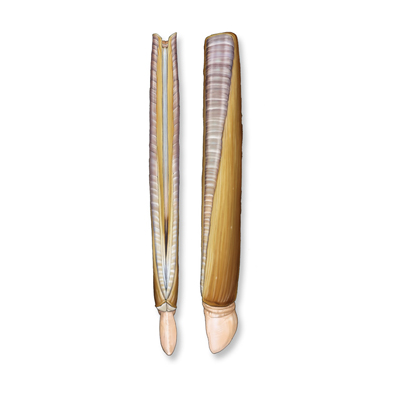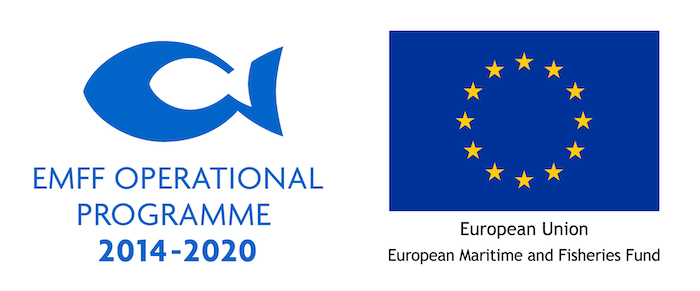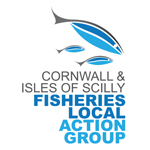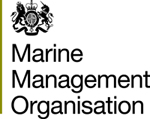

Razor clams are burrowing shellfish that are found living in muddy shallow areas such as estuaries and bays. They are becoming increasingly popular with chefs for their unique taste and texture.
Avoid eating clams harvested using illegal methods such as electrical fishing. Choose clams harvested in the wild by sustainable methods such as hand-gathering only. Avoid eating undersized animals (less than 10cm) and wild clams harvested during the spawning season (May - September). Make sure you only eat razor clams that have been properly depurated (to remove potential pollution) and well cooked. (Cefas 1999). As habitats suitable for razor clams are limited in Cornwall and there is no limit on catches there is a risk that this species could become over collected. Razor clams are often harvested as juveniles before they have reached maturity. Avoid eating undersized animals, always choose or collect razor clams above 100mm shell length, the current EU Minimum Landing Size. A MLS of at least 130mm has been recommended to ensure razor clams are not harvested before reaching maturity.
3.63 tonnes of razor clams were landed to Cornish ports in 2019 with a total value of £25k (MMO data).
Updated March 2023
Cornwall Good Seafood Guide rates fish on sustainability using a scale of 1 to 5.
1, 2 and 3 are recommended, Fish to avoid are rated 5.
We use the system devised by the Marine Conservation Society (MCS) so our scores are comparable with the scores produced by MCS for the UK and fisheries from all around the world. For more information on scoring click here.
Razor clams are bivalve molluscs each one having two long curving rectangular shells. There are 6 species found in British intertidal waters. 2 are of commercial importance, namely Ensis siliqua and Ensis arcuatus. Spawning occurs in summer. Fertilised eggs develop into mobile larvae hours after fertilisation. The larval phase includes several stages and lasts for about 3-4 weeks, during which time they drift with the current. The larval phase ends when larvae settle, attaching themselves to sand or shell by byssal threads. At around 0.5cm length juveniles burrow into sand. Relative to other commercially important bivalves razor clams are long-lived, slow growing, and attain sexual maturity late in life. They may survive to 10-15 years and an average adult can reach a size of 12.5cm, although growth will cease by age 10. E.siliqua and E.arcuatus can live in excess of 20 years. Maturity is reached at sizes above 100mm. They are filter feeders and normally lie vertically in the sediment with 2 small siphons, through which they feed, visible on the surface. Razor clams burrow into the sediment around the extreme low water mark and in the shallow subtidal and are capable of rapid burrowing if disturbed.
There have been no specific studies of razor clam populations in Cornish waters however they are widely distributed in intertidal waters throughout UK and temperate waters. Various bodies e.g. Natural England, Cefas, Sea Fishery Committees, Local Authorities etc. have responsibility for their protection or management in UK coastal waters. Razor clams were classed as under-utilized species in the CEFAS report identifying underutilized species (Catchpole.T 2011).
Collection of razor clams is prohibited on privately owned seabeds, including the Helford which is owned by the Duchy of Cornwall and commecial shellfish fishing is strictly controlled. Collection by divers is controlled by HSE regulations. There is a minimum size of 100mm. There are currently no bag limits controlling the numbers harvested. This means that there is potential for overharvesting particularly as the specific areas where razor clams can be found are very limited in Cornwall. EU minimum landing size is 10cm.
Dive collection of razor clams is not a large scale fishery in Cornwall, there are very limited areas available (designated razor clam shellfish waters, monitored by Port health and CEFAS) and changed HSE legislation is thought to have made diver collection uneconomically viable unless illegal electofishing is employed. Stocks are unstudied. There is potential for localised over-collection due to limited habitat area.
In Cornwall razor clams are only harvested by hand-gathering on foot or by diving. In recent years there has been a marked increase in commercial and recreational fishing effort on this species, and there have been several fishers prosectued by CIFCA for illegal electrofishing and diver collection for this species. Mechanical methods such as suction or hydraulic dredge are not currently being used. There are few areas where hand collection at low tide can be carried out commercially and there are no such areas that are classified as shellfish waters for Razor clam currently so this method can't be currently carried out commercially and has been removed from the Cornwall Good Seafood Guide ratings.
Choose clams harvested in the wild by sustainable methods only (such as hand-gathering, raking and manual digging). Avoid wild clams harvested during the spawning season (May - September). Razor clams are often harvested as juveniles before they have reached maturity. Avoid eating undersized animals, always choose or collect razor clams above 10cm, the current EU Minimum Landing Size. A MLS of at least 130mm has been recommended to ensure razor clams are not harvested before reaching maturity. Some illeagle electric fishing has been reported in Cornish waters.
Identifying underutilised species - Tom Catchpole, Cefas, January 2011 (This project was funded by Defra)
A.Younger 1999, Determination of Appropriate Conditions for the Depuration of
Razor Clams C0725, Centre for Environment, Fisheries and Aquaculture Science, Weymouth
www.fishonline.org
MMO landings data






Cornwall Good Seafood Guide is underpinned by the Marine Conservation Society (MCS) Good Fish Guide. The first UK consumer guide to sustainable seafood. For more information visit www.fishonline.org
Cornwall Good Seafood Guide is here to help us all make sustainable seafood choices. Choices that will help us keep the oceans healthy and Cornish fishers' futures safe. This website is funded by Cornwall Wildlife Trust. If you would like to make a meaningful difference to the health of our oceans, please consider making a donation to the Cornwall Wildlife Trust Ocean Emergency fund. Your donation will help safeguard these remarkable environments, ensuring that they continue to thrive for generations to come. Together, we can be stewards of the seas and champions for a healthier, more sustainable future.